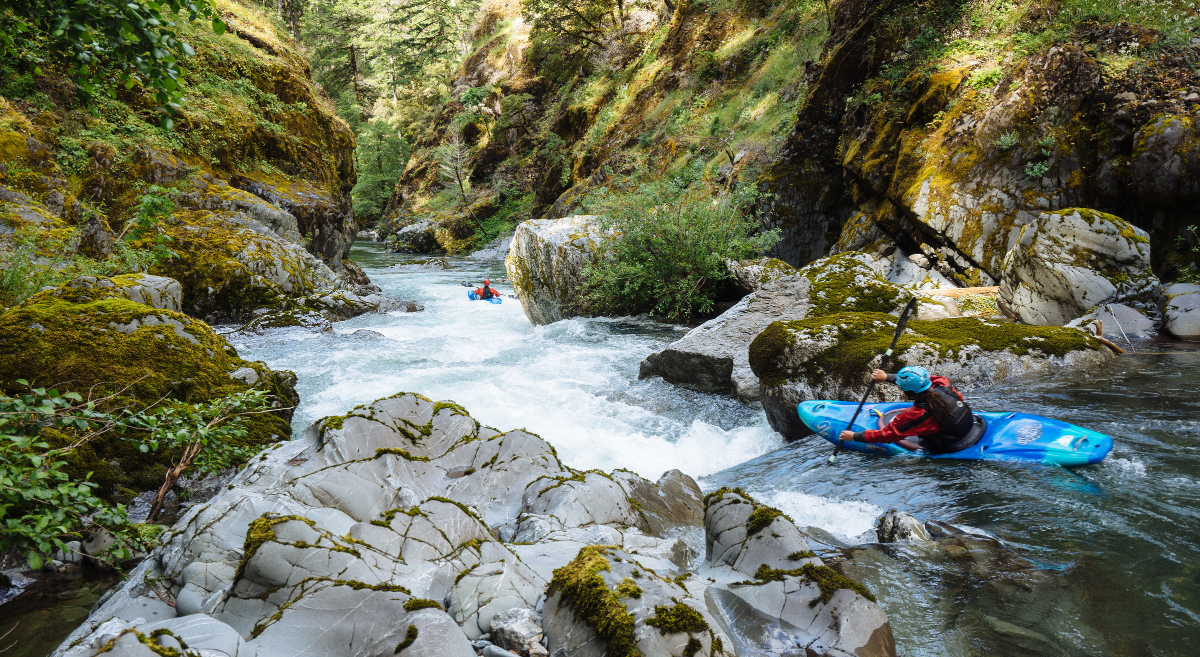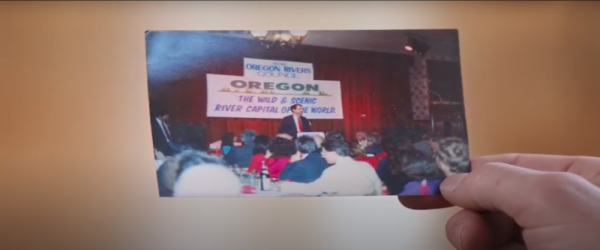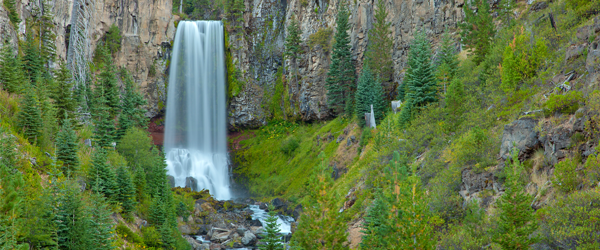
Indigo Creek: Indigo Creek is a textbook example of how important tributaries are to a watershed, and how critical it is to maintain healthy waterways from the headwaters on down. This remote stream feeds into the Wild & Scenic Illinois River, which itself is a tributary of the Rogue River. Indigo Creek is known for its exceptional water quality and near-pristine fish spawning and rearing habitat, and during summer’s low flows it provides 15-20% of the Illinois River’s water. The world-class fishery of the lower Rogue would not be what it is without cool, clean tributaries like Indigo Creek. Though difficult to access, this secluded creek also provides a truly intimate and challenging paddling experience for whitewater boaters – though it’s not for the faint of heart.
A love letter
How do we know a place is “special”? Is it about a feeling? How many generations need to visit and feel the same way before it gets the title? Does it need to meet some scientific standard?
As far as I’m concerned, what makes a place special is not always quantifiable. Sometimes, they’re special because they just are – there’s something intangible about them. For many, those special places are rivers. They connect us in nearly every way imaginable: communities upstream and downstream, families throughout decades. They even connect multiple species through a food web; if you eat an adult salmon, you’re connected to whatever it ate – the caddisfly it scooped from an eddy on its natal stream, the juvenile chum salmon it chased down in the sea.
Likewise, the River Democracy Act, legislation that would designate just under 4,700 miles of rivers as Wild & Scenic, connects Oregonians across the state. This proposal has created the opportunity for individuals from all walks of life to become involved in the lawmaking process and nominate their own special place for a Wild & Scenic designation. These are protections that will last beyond my lifetime and provide an opportunity for those rivers and their surrounding landscapes to be preserved as “special” for generations to come.
How Oregon’s biggest river bill came to life
To understand where the River Democracy Act came from, we have to rewind back to the 1980s when a then-Congressman Ron Wyden first dipped his toes in the Wild & Scenic pool. In those days, Oregon was still intensely logging public lands, and safeguards for the state’s rivers and waterways were severely lacking: only 317 of our total 110,994 miles (0.003%) of our rivers were protected. The Wild & Scenic Rivers Act seemed like a natural solution to this issue; the Rogue River was one of the original 8 rivers protected when the Act was passed, and it’s been a wild success ever since.
With that history in mind, Congressman Wyden worked with Oregonians and other members of our Congressional delegation to create the 1988 Oregon Wild and Scenic Rivers Act. He sees the River Democracy Act of 2021 as a continuation of that legacy.
To describe its origin story, now-Senator Wyden said it best himself in a recent short film that Pacific Rivers created about the River Democracy Act:
“This [bill] embodies all the dreams we had back then. But I always wanted to pick up on this incredible legacy with this bill. We’re fulfilling that vision. We’re going to call it the River Democracy Act because the recommendations for the future of the Wild & Scenic Rivers system in Oregon didn’t come from Washington DC – it came from Oregonians in every nook and cranny of our state.”
To say that his efforts were well received would be an understatement. At his “Rivers Town Hall” in Bend in 2019, it was standing room only. A film screening I co-hosted on the topic was so popular we nearly had to turn people away in fear of breaking fire code.

Senator Ron Wyden, holding a photo of himself from 1988. The sign behind him reads: “Oregon: the Wild & Scenic River capital of the world”.
River lovers of all stripes showed up: students, guides, members of watershed councils, hunters, anglers, retired biologists, drinking water providers, and more. Breweries nominated the clean water sources that make their beer top-notch. Anglers nominated their favorite stretches of fishy waters. In my neck of the woods in Central Oregon, a group of local middle schoolers teamed up to nominate Tumalo Creek – a place they recreate with their families and conduct citizen science projects for class. Their nomination letter even got them on the front page of the Bend Bulletin:
“We believe that Tumalo Creek should be designated as a Wild and Scenic River to protect it for years to come because it represents everything that we love in Bend, OR – the beautiful outdoors, being with friends/family, and having fun! [We] feel the need to protect the creek because it is part of our community.”

Tumalo Creek in Bend, Oregon.
All told, after more than two years of public meetings, town halls, and intense discussions and research, the River Democracy Act accrued more than 15,000 nominations from Oregonians across the state. It’s heartening to know that river-lovers across multiple generations recognize the importance of protecting our waterways, and that Senator Wyden took their nominations seriously.
Jeff Merkley, Oregon’s other senator, joined Ron Wyden’s introduction of the River Democracy Act in February of this year. I think it’s safe to say that it’s the first of its kind as far as magnitude goes. The proposed 4,700 miles of additions to the National Wild & Scenic Rivers System would bring Oregon up to nearly 6% of our rivers protected. It has the potential to make us a nationwide leader on river protection.
Since its introduction the bill has received enthusiastic support from businesses, and elected officials from across the state. In mid-June, a collection of over 50 breweries from across Oregon recently published a letter showing their support. And they’re backed by Oregonians: a January poll showed that 87% of surveyed Oregonians support designating more Wild & Scenic Rivers, including 75% of Republicans.
What is Wild & Scenic & what’s in the bill?
The anatomy of a Wild & Scenic River is pretty variable, but a good general rule is that no new dams can be built and no new mining claims can be staked. The river gets a buffer of protection on either side – in some places this means a backcountry roadless area, and others are home to some of Oregon’s most beloved trails (think: the Rogue River trail). Clearcutting and old-growth logging generally don’t make the cut as acceptable pursuits, but all sorts of recreation activities do, depending on the development level of the area.
As our Wilderness Program Manager Erik Fernandez puts it, “You can go hiking, hunting, fishing, swimming, camping, trail running, mountain biking, snowshoeing, skiing, and the like. Just leave your recreational bulldozer at home!”
At the end of the day, it’s all worth it
When the bill passes and is signed into law, what will we get for our collective efforts? I was pondering this question recently as I hiked a trail along Central Oregon’s absolutely iconic Metolius River.
If you haven’t been to the Metolius yet, I hope one day you can find time to visit. It’s easily one of the most beautiful rivers I’ve ever glimpsed. Springing forth from seemingly nowhere near the base of Black Butte, it has some of the clearest, bluest water I’ve ever seen in my life. Towering ponderosa pines line its banks and cunning fish fill its waters.
A number of private cabins flank the shoreline outside of Camp Sherman, and on this particular occasion I was walking on the river trail thinking, “Wow, it sure would be nice to own one of those!” Immediately following that thought came a wave of intense gratitude, because I realized I will never need to own a cabin to enjoy this place – it’s part of our public lands system, and already designated Wild & Scenic! It was originally protected as part of Senator Wyden’s efforts in the ‘80s, and here I am nearly 40 years later still reaping the benefits.
This is what the Wild & Scenic Rivers Act – and Senator Wyden’s River Democracy Act – is all about. This is the beauty of public lands and the protections that envelope them. There are a lot of uncertainties in this world, and there are certainly things coming down the pike that we can’t yet imagine. But through it all these places will be protected, thanks to this bill and bills like it.
It’s not too often that regular people have the chance to contribute to legislation in such a meaningful way, but in Oregon it just makes sense. We have a strong history of politicians who care about our rivers, and an even stronger history of Oregonians standing up for special places. 15,000 nominations can’t lie - people across the state showed up in droves because they care about our public waterways and all that they provide. Though we may have different motivations, the end goal is the same: make sure these places are here for future generations to admire and enjoy. I hope you’ll join me in doing all you can to make that vision a reality.
Senator Ron Wyden photo courtesy of Pacific Rivers Coalition
Tumalo Creek by Dave Burdick

